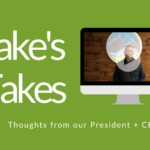
Businesses create intellectual property (IP) whenever they establish a proprietary process, product, logo, literary work, or other original creation. If your business has IP, there are certain legal protections you can and should put in place to safeguard it from imitation or misuse.
Here’s what every small business should know about IP and how to protect it.
Common reasons small businesses overlook IP protections
Many entrepreneurs make the mistake of not prioritizing IP protections, and some don’t think about it at all. Warren Tuttle, Co-Chair of the Creator Committee of the USIPA and Founder of Tuttle Innovation, attributes this willingness to overlook IP protections to a lack of awareness on the topic, a lack of resources to pay for legal services, and a lack of understanding of how IP can impact business.
“I think a lot of business owners are probably unaware of how they could be helping themselves,” Tuttle said. “We [the USIPA] just recently did a survey of consumers … and found that they don’t really understand it a whole lot.”
While IP protections don’t apply to every business, Tuttle believes more entrepreneurs should be aware of what these protections entail and their benefits to a business owner.
“With [IP], you have now purchased… the right to defend yourself, [but] it can also be expensive,” Tuttle said. “You really have to be committed to it. And the [IP] has to be quite specific and really be of value to pursue it.”
[Read more: 12 Ways to Protect Your Startup’s Intellectual Property]
Tips for keeping a business’s IP protected
Following these steps can help ensure your IP remains protected in case of infringement.
Learn about the different types of IP
There are various types of IP, including:
- Patents: Patents can protect a company’s method or process for up to 20 years if the creation is deemed useful and novel.
- Trademarks: Trademarks protect brands — including their
logos, taglines, and even company names — from imitation. To trademark a
business in the United States and obtain commercial rights, you just
need to be the first to use it. However, through the United States
Patent Trademark Office (USPTO), you can register your trademark for
stronger protection. - Copyrights: Copyrights don’t require you to file
anything; instead, it begins at the moment something is created.
However, federally registering your copyrighted work allows for your
business to have a stronger case of ownership, should infringement
occur. - Trade secrets: Businesses that have commercially
valuable information that must remain confidential can help ensure this
happens through nondisclosure agreements (NDAs) and by limiting the
number of people who have access to the information.
To determine what IP assets your business has, the USPTO released an IP Identifier tool that identifies IP using questions and real-life examples and offers protection solutions.
Many entrepreneurs make the mistake of not prioritizing IP protections, and some don’t think about it at all.
Get help filing for the IP protection(s) you need
To get started with IP protections, Tuttle suggests obtaining a provisional patent, or a temporary patent filling for the first 12 months. A provisional patent is an inexpensive way to protect your IP; depending on your knowledge of the patent process, you may even be able to file it on your own. However, he advised against going the DIY route long-term.
“Any type of real filing … requires a really good attorney,” Tuttle warned.
To choose an attorney, Tuttle suggests determining whether you’ll want to work with a big corporate firm or a smaller firm, as the latter is often less expensive. He recommended an organization called the American Intellectual Property Law Association (AIPLA), which has member attorneys across America.
Stay up to date on IP news and trends with the USPTO and local organizations
To get the most out of IP, Tuttle recommended keeping current about general IP updates and protection. As a first step, you can visit uspto.gov and educate yourself on the patent system.
For inventors looking to connect with others, Tuttle highlighted some available resources.
“There are inventor groups or organizations locally all around the country,” he said. “You can do a quick search online [or] go on the USPTO’s website to find out where these clubs are … The United Inventors Organization also has a listing by map [where] you can put in your locale [to] show… where the nearest club is.”
[Read more: Can an Employee Own Intellectual Property?]
CO— aims to bring you inspiration from leading respected experts.
However, before making any business decision, you should consult a
professional who can advise you based on your individual situation.
To stay on top of all the news impacting your small business, go here for all of our latest small business news and updates.
CO—is committed to helping you start, run and grow your small business. Learn more about the benefits of small business membership in the U.S. Chamber of Commerce, here.
Subscribe to our newsletter, Midnight Oil
Expert business advice, news, and trends, delivered weekly
By signing up you agree to the CO—
Privacy Policy. You can opt out anytime.
Published March 08, 2023
Sammi Caramela








